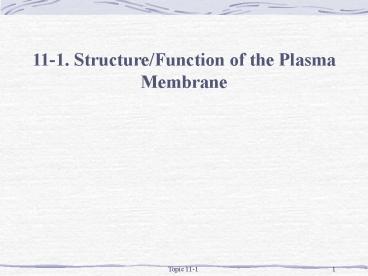111' StructureFunction of the Plasma Membrane - PowerPoint PPT Presentation
1 / 22
Title:
111' StructureFunction of the Plasma Membrane
Description:
Active via energy-coupled transport processes. Both lead to a net flux of an ion or compound ... A compartment with high solute concentration hypertonic ... – PowerPoint PPT presentation
Number of Views:41
Avg rating:3.0/5.0
Title: 111' StructureFunction of the Plasma Membrane
1
11-1. Structure/Function of the Plasma Membrane
2
Movement of Substances across Cell Membranes
- Plasma membrane dual function
- Retain dissolved materials
- Allow exchange of materials
- Two means of movement
- Passive
- Active via energy-coupled transport processes
- Both lead to a net flux of an ion or compound
- Influx and Efflux are not balanced
3
Movement of Substances across Cell Membranes
- Four processes are known
- Simple diffusion through lipid bi-layer
- Simple diffusion through aqueous, protein-lined
channels - Facilitated diffusion
- Active transport
4
Movement of Substances across Cell Membranes
- Energetics of solute movement
- Uncharged may move via diffusion gradient
- Charged two gradients
- Chemical gradient
- Electrical potential gradient
- Together form an electrochemical gradient
5
Movement of Substances across Cell Membranes
6
Movement of Substances across Cell Membranes
- Diffusion through membranes
- Rate dependent on polarity and size
- Polarity estimated using the partition
coefficient - The greater the lipid solubility the faster the
rate of diffusion - Smaller molecules penetrate more rapidly than
(similar) larger molecules - Highly permeable to O2, CO2, NO and H2O
7
Movement of Substances across Cell Membranes
- Diffusion through membranes
- Large polar molecules sugars, aa,
phosphorylated intermediates poor permeability - These are essential for cell function must be
actively transported
8
Movement of Substances across Cell Membranes
- Diffusion of Water
- Water moves much more rapidly through the
membrane than solutes - Membrane is termed semi-permeable
- Movement of water is termed osmosis
9
Movement of Substances across Cell Membranes
- Diffusion of Water
- A compartment with high solute concentration
hypertonic - A compartment with low solute concentration -
hypotonic
10
Movement of Substances across Cell Membranes
- Diffusion of Ions through Membranes
- Plasma membrane is highly impermeable to
- Na, K, Ca2 and Cl-
- But their conductance is critical
- Ion Channels provide the mechanism for their
transport
11
Movement of Substances across Cell Membranes
- Diffusion of Ions through Membranes
- The patch-clamp technique of Sakmann and Neher
12
Movement of Substances across Cell Membranes
- Diffusion of Ions through Membranes
- Most channels exist in an open or closed
conformation - Term gated two categories
- Voltage-gated channels
- Ligand-gated channels
13
Movement of Substances across Cell Membranes
- Diffusion of Ions through Membranes
- Voltage-gated channels K channels
- All have similar molecular architecture
- N- and C- terminals on cytoplasmic side
- Six membrane-spanning domains S1-S6
- A single channel consists of four identical
polypeptide subunits - Subunits arranged symmetrically around
ion-conducting pore
14
Movement of Substances across Cell Membranes
- Diffusion of Ions through Membranes
- Voltage-gated channels K channels
- Between S5 and S6 segment H5 (also termed P)
dips into the center and forms the pore (4
polypeptides)
15
Movement of Substances across Cell Membranes
- Diffusion of Ions through Membranes
- Voltage-gated channels K channels
- P region contains conserved pentapeptide
Thr-Val-Gly-Tyr-Gly - Termed the selectivity filter
16
Movement of Substances across Cell Membranes
- Diffusion of Ions through Membranes
- Voltage-gated channels K channels
- S4 contains multiple ve charged aa which act as
voltage sensors
17
Movement of Substances across Cell Membranes
- Facilitated Diffusion
- Many examples of diffusing substrates which
selectively bind to a membrane-spanning protein-
a facilitative transporter - Mediate solute movement in both directions
- Dependent on concentration gradient
- Example glucose transporter
18
Movement of Substances across Cell Membranes
- Facilitated Diffusion
- Glucose transporter
- Continued transport achieved by phosphorylating
glucose and maintaining the glucose gradient - Glut 4 is the insulin-responsive glucose
transporter
19
Movement of Substances across Cell Membranes
- Active Transport
- Typical specific ion concentration gradients are
very steep - For cells to develop such steep gradients
requires active transport - Requires coupling of energy
- Hydrolysis of ATP
- Active transport proteins termed pumps
20
Movement of Substances across Cell Membranes
- Active Transport
- Enzyme driven
- Na/KATP-ase termed sodium-potassium pump
- Drives the transport of ions in one direction
- For each ATP hydrolysed
- Three Na pumped out
- Two K pumped in
21
Movement of Substances across Cell Membranes
- Active Transport - sodium-potassium pump
- Conformational changes in the protein change its
affinity for the ions - Achieved by phosphorylation of the protein
- Consider its importance!!!!
- Consumes approx 1/3 of the energy of most animal
cells (2/3 the energy of nerve cells)
22
Movement of Substances across Cell Membranes
- Active Transport - sodium-potassium pump































